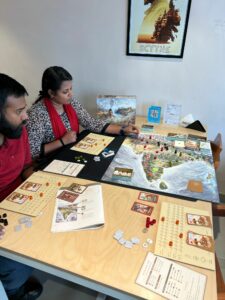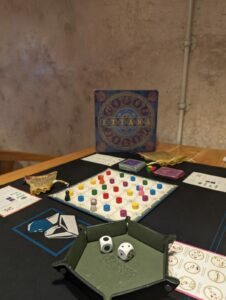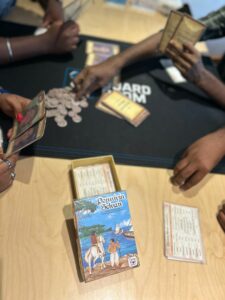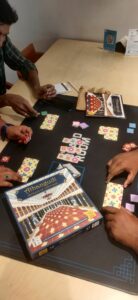From forgotten tales to thrilling conquests, board games these days are offering an interactive gateway for players to our country’s rich heritage.

Board games rooted in history could spark an interest in players to learn more about the topic. (The Board Room)
Saverio E Spagnolie, a mathematics professor at the University of Wisconsin-Madison, along with three other designers, recently created a board game. It made headlines in India as the game was about the medieval Deccan empires. Titled Vijayanagara: The Deccan Empires of Medieval India, 1290-1398, the game lets players take on the roles of Delhi Sultanate, the Bahmani Kingdom and the Vijayanagara Empire. They can rally local amirs and rajas to their cause, construct temples and forts as they battle for supremacy.
Published by GMT Games, Vijayanagara treads a territory that is not familiar to most, including many Indians. However, in less than two weeks, the game has already sold 1,020 copies and has piqued the curiosity of India’s popular historians as well as enthusiasts.
There is a reason.
Historical board games such as these invite players to step into the shoes of historical figures. It lets them them navigate the intricate web of political, economic, and military conflicts that have defined human civilisation. This could possibly leave a lasting impression on players and spark an interest in learning more about the topic.
While textbooks and lectures provide valuable insights on the rich tapestry of Indian history and heritage, board games are now being looked at as an interactive way to immerse children as well as adults in the captivating stories of India’s past. They could be powerful educational tools, as they engage players in strategic thinking, problem-solving, and social interaction.
According to Vinita Sidhartha, founder of Chennai-based Kreeda Games, there are two kinds of traditional games— games that are rooted in traditions and games that people used to play traditionally.

Delving in to the past, one roll at a time. (The Board Room)
Games rooted in history and tradition are in a way offering a retelling of the past, Sidhartha shares.
“Just like books and movies, these games also offer a retelling of what happened in the past. It’s a person’s or an organisation’s interpretation of it. Since it’s narrative in its essence, as you play, you get to familiarise yourself with a story or some historic information,” she notes.
Regardless of the format, it’s important for history and traditional stories to be retold, she adds.
“It’s part of our oral tradition. In board games, the stories may be portrayed in a different format often combined with stories, facts, and trivia. But it’s still important.”
While traditional games like Chaupad or Snakes & Ladder don’t have a narrative to it, they are rooted in our past.
“You don’t play such games to learn about your history or culture. But they were created at a time when people had very few pastimes– way before TV and radio. It has been passed on from generation to generation,” she shares.
That said, everything depends on how skillfully the game has been crafted. “It’s easy to make it an educational tool. But it should be equally fun as well.”
According to Sriram Mahalingam, co-founder of The Board Room, there are several games in the market that are centered around history and culture. And there are takers for it too.

There is a demand for games that sheds light on Indian heritage. (The Board Room)
He shares a host of examples, “There is Bharata 600 BC– which is set in pre-invasion India. There were about 15 kingdoms in existence at that time. The players can assume the role of the rulers and strategically build armies, manage resources, and expand their kingdom. Then there is Rajas of the Ganges where players are Rajas trying to develop their estates.”
Similarly, there is Athangudi: Artisans of Chettinad where you play the role of a master artisan who has to lay the floor of a Chettinad Mansion using Athangudi tiles. Whereas in Gandhi: The Decolonization of British India, 1917–1947, players compete to determine the future of India – whether the transition to home rule be a peaceful one, will India be split apart by partition or civil war, or will it remain firmly in the grip of the empire.
There needs to be more awareness on games like these, says Mahalingam.
“If there is a right mix of theme and mechanics, these games can get very popular. A mechanically rich and balanced game centered around a good theme can really offer a gripping experience,” he notes.
For more people to welcome these games, a certain level of ease and replayability should also be there, he adds.
“If the game doesn’t offer something new every time it’s played, it’s not going to live long. Every time someone plays it, they need to get something different out of it. If that happens, people will play it over and over again,” he shares.
The tile-laying game called Hampi, where the player gets to develop the landscape of Hampi — tile by tile — and Cholas where the player is a sculptor who build temples and gets rewarded by the king, are some examples.
“In Cholas, you build the different parts of a temple. There is a mechanical element to it which makes the game more re-playable. There is also East India Companies where players manage a large shipping company that trades with far flung trading posts in India. They must manage their ships and invest in buying shares of their own company or those of their competitors. Through the game, one can understand how the EIC invaded India, and how trading happened in those times,” he explains.
While playing these games, players actively participate in the exploration of history, absorbing information and developing a deeper understanding of key concepts. For instance, a game set in the Chola Empire could challenge players to expand their territory through diplomacy and conquest while managing resources and creating trade routes. As they strategise, they learn about the rise and fall of one of South India’s powerful dynasties.

When you play the game, you are getting involved in the story. (The Board Room)
Similarly, a game centered around the spice trade routes of Kerala could shed some light on the region’s maritime history, economic importance, and cultural exchanges with foreign lands.
People are attracted to these games because these are incidents that they have only read in books, Mahalingam points out.
“When you see it on the table and get to play with it, you feel more involved. And that makes it a good medium for people to learn about history and heritage.”
Board games are highly stimulating, he explains.
“Be it a business game or a stock market game, it stimulates a particular situation where the player gets to assume roles. When the game is based on history, the player takes decisions, carries out an action, goes to various locations. So to familiarise someone with a concept, be it a child or an adult, games work very well.”
I don’t know if people actually learn from these games, Nadir Hussain, founder of Kochi-based Le Spot Table Toppers weighs in.
Hussain is set to introduce games like Vallamkali – a game based on the iconic boat races of Alleppey, Indus 2500BC– a civilisation building game surrounding the Indus Valley Civilisation, Karigar-e-Taj– a strategy board game where players lead the artisans to build the Taj Mahal and Yudhbhoomi– where you can play campaigns based on Indian history in his board gaming community.

More than education, the purpose of these games is to stimulate your brain. (The Board Room)
“These are games that are created around a historic theme or a lore. But in most of them, the mechanism has got nothing educational about it. It’s either tile placement or worker placement. For instance, in Karigar-e-Taj, the mechanism is building the Taj Mahal, that’s the theme. But you are not learning anything about its history,” he shares.
More than education, these games are for stimulating your brain more, he adds.
“It’s about getting off the screens and focusing on something else for a while. It offers a unique experience where you interact with people, create strategies, plan etc. That’s the main objective. If that helps in igniting your curiosity about something, it’s a bonus,” he shares.
Most Indian publishers are now focusing on creating games rooted in Indian history and heritage, says Mahalingam.
“It’s a niche in itself. The makers have understood that Indian culture is something they understand and gives them an edge over international publishers,” he shares.
Board game industry in India was ignored for a long time but now, it’s booming, he adds.
“What is happening in India right now is very positive. As a community, we are very social. When at home or out with friends, we like to have fun with a board game. All the board game cafes across cities are a proof of its resurgence. I see a lot of people buying games and playing at home. So it makes a lot of sense for Indian publishers to introduce games that are based on Indian heritage,” he informs.
Combining the excitement of gameplay with historical storytelling, there are several games in the market that inspire curiosity, foster learning, and ignite a passion for the past among participants. So why not roll the dice, draw a card, and embark on an adventure through time?

Jun 05, 2024

Jun 05, 2024

Jun 03, 2024

Jun 03, 2024

May 08, 2024

Apr 16, 2024